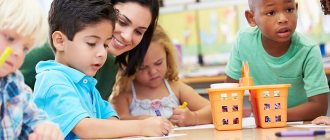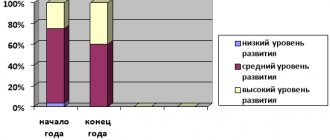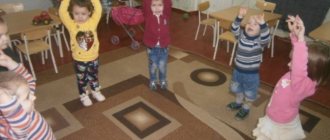The work of a kindergarten teacher is extremely important for the future of the entire country, because he is entrusted with the most valuable thing in every family - children. And today’s preschoolers are the future of the state, which is why the government pays so much attention to issues of education and training, starting from the very “starting” levels - nurseries and kindergartens. For the full development of pedagogy, each employee of a children's educational institution must know the main directions of the teacher, directly related to his work as a specialist in the education of young children.
The main activities of a preschool teacher
In preschool activities, mental, moral, labor, physical and artistic-aesthetic education are distinguished, but in recent years more and more attention has been paid to environmental and legal education. This is due to the fact that the socio-economic and political situation in the country and throughout the world is rapidly changing, and modern children in these areas are much better developed than their peers of previous years. In addition, the requirements for the development of a full-fledged personality provide for the all-round development of the child, so ignoring the issues of modern times will not bring anything good. Preschool teachers have to use much more knowledge and skills than in previous years, as this is required by the environment and the changed rules for assessing the activities of the teacher and the requirements for them.
The main directions of the teacher’s pedagogical activity include the following sections:
- Self-education.
- Organization of problem-search work for a children's team.
- Expanding the skills and abilities of students through the introduction of new information technologies into their activities.
- Expanding the educational space of pupils.
- The use of special classes to prepare students for school using ICT.
- Expanding the teacher’s own horizons and educational space using the latest information technologies.
The work of preschool teachers and educators is carried out in different directions, but, in essence, is aimed at one most important goal - the formation of a child as an integral creative personality. Therefore, one of the most important tasks of any educator is the harmonious unification of all areas of their activities to achieve their goal.
In the pedagogical literature, there are often 5 main areas of activity of a teacher in a preschool educational institution. These concepts resonate with the job responsibilities of a teacher, but do not copy, but complement them.
You can find many different definitions of the main directions of a teacher’s work, but they all, in essence, boil down to the following brief and succinct formulations:
1. Care.
2. Education.
3. Supervision.
4. Organization of educational work.
5. Conducting educational work.
This can be deciphered as follows:
- Care is caring, patronizing and providing assistance to a pupil. It concerns both training and education, and purely human feelings, as well as the health of the child. The teacher creates a psychologically healthy atmosphere in the children's educational institution, thanks to which the child feels calm, confident, and safe.
- Education is a broad concept that includes both the inculcation of universal human norms and the formation of a free, fully and comprehensively developed personality.
- Supervision involves monitoring not only behavior and academic performance, but also identifying various violations for the purpose of their subsequent correction and correction.
- Organization of educational work is planning and preparation of the entire learning process in a preschool educational institution. It includes numerous stages - from self-education to the production of the necessary visual material.
- Carrying out educational work is the actual learning process, which involves all the knowledge and skills accumulated by the teacher.
Also, the directions of the teacher’s work can be formulated as follows:
- Sports and recreation.
- Spiritual and educational.
- General cultural.
- General intellectual.
- Social.
The presence of several formulations does not introduce different interpretations into the definition of directions of educational activity, but only explains, “deciphers” them.
What kind of worker is this, what does he know and can do?
Before we figure out who a kindergarten teacher is and what requirements are placed on him, we note that when assessing the competencies of such an employee, the norms of special documents should be taken into account:
- Federal State Educational Standard (FSES) for preschool education, approved. By Order of the Ministry of Education and Science dated October 17, 2013 No. 1155;
- professional standard, approved. By Order of the Ministry of Labor dated October 18, 2013 No. 544n.
These two standards apply to everyone who belongs to preschool workers - nannies and educators, psychologists and speech therapists, music directors and physical education teachers who work in private and public kindergartens. And on their basis and information from the Unified Qualification Directory (USD) for the positions of managers, specialists and employees (the section concerning the qualification characteristics of positions for education workers), employers draw up job descriptions with responsibilities that subsequently guide both the employees themselves and their superiors.
If you intend to find out what a kindergarten teacher should know according to the Federal State Educational Standard, you will have to limit yourself to only the wording of officials about what they want from such an employee. He must have the competencies to create conditions for (see clause 3.2.5):
- regular communication with each child, taking into account his feelings and needs;
- support and development of children;
- establishing certain rules of behavior in different situations;
- normal interaction with parents.
Details about what knowledge and skills will be useful for a preschool teacher to perform their duties are listed in the EKS and the professional standard. The EKS states that he needs knowledge of laws and educational programs, the fundamentals of pedagogy and psychology, methods of educational work, basic information from the field of ecology, economics and sociology. To this are added skills in working with computer programs and multimedia equipment. In the professional standard, this list was supplemented with nuances taking into account the type of labor function. Thus, when performing developmental work as a teacher in a kindergarten, you will need the ability to form and implement individual development programs, and to fulfill the responsibilities of education, you need the ability to motivate children for educational and cognitive activities.
But all these are dry normative acts, and in real life, a kindergarten teacher is a person who loves children, has a great desire to become their first guide to adulthood, and knows how to resolve conflicts. It’s great if he manages to find an approach to each baby, provide first aid and cuddle the child. Such an employee must take care of his appearance, be able to speak correctly, and find an approach not only to the students, but also to their parents.
If we talk about educational requirements, then usually persons with secondary vocational or higher education in the field of pedagogy, psychology or sociology are appointed to the position of educator, preferably with work experience, knowledge of child psychology and speech therapy, methods of development of preschool children. Refresher courses wouldn't hurt.
To effectively perform the duties of a teacher in a kindergarten according to the Federal State Educational Standard and the professional standard, a person must have certain personal qualities, including:
- love for children and the ability to find an approach to any child;
- organizing abilities;
- positivity and cheerfulness;
- stress and psychological stability;
- communication skills and organization;
- speech literacy and high cultural level;
- the ability to make quick and correct decisions in any situation.
Important and mandatory qualities of a teacher are kindness, goodwill, hard work, responsibility, and accuracy.
ConsultantPlus experts looked at how to organize a family kindergarten. Use these instructions for free.
The main activities of the senior preschool teacher
A methodologist, or senior educator, acts as a link between the state education system, pedagogical and psychological science, advanced professional experience and the practical activities of the teaching and educational staff of a children's educational institution. As a result, the main directions of the methodological work of the teacher-methodologist become the promotion of the formation, development and implementation of the professional creative potential of the teaching staff of the preschool educational institution.
According to the requirements of modern legislation and professional pedagogical standards, the main activities of the senior educator and the entire methodological service are the following:
- Education and training of preschool children in kindergarten in accordance with the requirements of modern standards of pedagogy and psychology.
- Formation of the educational standard of preschool educational institutions on the basis of universal human values, the free development of the child as a full-fledged individual, in compliance with the priorities of the health and well-being of pupils. In the work of preschool educational institutions, adhere to the principles of respect for human rights and freedoms, love for one’s native country, nature and the environment, the formation of the foundations of a healthy lifestyle, and the absence of bad habits. It also requires the formation of the principles of citizenship, hard work and social responsibility, taking into account the age of the students.
- Adaptation of kindergarten activities to the characteristics of the physiology and psychology of preschool children, as well as to social orders.
- Ensuring the secularity of the educational process.
In his activities, the senior teacher of a preschool institution carries out methodological and educational work in order to achieve the following indicators:
- Introducing proposals and changes to the work plan of the preschool educational institution.
- Improving the qualifications of teachers and educators.
- Support and assistance to the teaching staff in self-education and improvement of professional knowledge.
- Drawing up a schedule of classes taking into account the age groups of students.
- Providing methodological assistance to educators, primarily young professionals and newcomers to the work of a particular preschool educational institution.
- Exchange of employee experience.
- Working with parents.
- Providing groups with the necessary aids, books and toys.
- Analysis of the state of educational, educational and methodological work in preschool educational institutions and the adoption of measures to improve and improve it.
- Certification of educators and teachers of children's educational institutions.
Ensuring the fulfillment of all these complex and multifaceted tasks is possible only with coordinated collective work of all representatives of the educational and educational process.
The work of a teacher in the main areas of the Federal State Educational Standard for Preschool Education. Presentation for a lesson (group) on the topic
The work of a teacher in the main areas of the Federal State Educational Standards and Education
We live in a rule of law state. The Federal State Educational Institution for Education is the main legislative document for constructing the entire educational process by preschool teachers. The standard was developed on the basis of the Constitution of the Russian Federation, taking into account the Convention on the Rights of the Child and is the subject of regulation of relations in the field of education.
If earlier the preschool period was considered as preparation for the next stage of life - school, then today one of the attitudes towards preschool childhood is to support its diversity: the preservation, uniqueness and intrinsic value of childhood, as an important stage in the overall development of a person.
This is an initial and very important stage. After all, from birth to 7-8 years, a child acquires significantly more skills than later (learns to walk, talk, acquires self-care skills, etc.)
Focusing on the requirements of the Federal State Educational Institution for Education, in their work, educators take into account:
- Individual characteristics of the child (life situations, health, etc.);
- Opportunities for a child to master the program.
The educational process in our preschool educational institution is aimed at solving problems that are defined by the Standard:
- Protection and strengthening of children’s physical and mental health, emotional well-being.
A gymnastics matinee is held in kindergarten; physical education, including outdoors; sports holidays; physical exercises; hardening procedures; Children enjoy drinking oxygen cocktails. A favorable atmosphere has been created: the teachers are friendly towards children, use different techniques, carefully prepare for events...
- Ensuring equal opportunities for the full development of every child, regardless of gender, nationality, social status, including the child’s disabilities.
Our institution is visited by children of different nationalities (Tatars, Azerbaijanis, Armenians and other nationalities). All children have equal opportunities to receive educational services. Preventive measures are taken for children with flat feet. Children with speech impairments receive qualified pedagogical assistance and individual support.
- Ensuring continuity of goals, objectives and content of education at different levels.
Our educational institution cooperates with nearby schools and the library. The children attend school, go on excursions, take part in various competitions and events organized by other educational institutions.
- Creating favorable conditions for the development of children in accordance with their age and individual characteristics and inclinations.
In our kindergarten, we have organized a developing subject-spatial environment that promotes the realization of the creative potential of each child as a subject of relations between adults and peers. In each age group, so-called functional, variable centers are equipped (art activities, book, theatrical, constructive , gaming, productive, etc.). Didactic, educational games are selected according to the age of the children. Play equipment is multifunctional (materials suitable for use in different types of activities: children's furniture, modules, mats, natural materials, etc.); easily transformed depending on the educational or gaming situation (a chair at a table - dolls drink tea, a car seat, just a cube; a table - for drawing, a store counter, etc.). All games and toys are within reach, i.e. accessible to children and safe. The organization of the educational space provides: gaming, motor and creative activity, and the opportunity for children to express themselves.
- Combining training and education into a holistic educational process.
During the classes, tasks are set not only of a cognitive and developmental nature, but also of an educational nature. For example: we draw a houseplant with children - we consolidate knowledge about the structure of a plant, develop memory, eye, fine motor skills and cultivate a caring attitude towards nature.
- Formation of a general culture of children’s personality – values of a healthy lifestyle, moral and cultural values, aesthetic qualities.
The preschool educational institution carries out activities that promote the development of the above qualities. These include daily play activities, entertainment and holidays. It has already become a tradition to organize “Autumn Festival”, “New Year”, “Mother’s Day”, “Mom, Dad and I are a friendly family”, etc.
- Ensuring variability and diversity of program content and organizational forms.
Preschool teachers work according to an educational program based on the p/r program. Veraxes. This is a comprehensive educational program that includes all educational areas. Additional programs are also used: “Colored Palms” by Lykova for fine art activities; “Environmental education in kindergarten” by O.A. Solomennikov.
- Formation of the sociocultural environment.
At the NOD, teachers talk with children on the topics: “My family”, “My homeland Russia”, “Beloved Yekaterinburg”, “All professions are important”, etc.
- Providing psychological and pedagogical support for the family and increasing the competence of parents (legal representatives) in matters of development and education.
Our kindergarten is a consultation point for parents whose children do not yet attend kindergarten and can contact teaching staff for advice. The kindergarten organizes parent meetings, consultations, round tables, and briefings. There are information centers in the lobby and in each group.
The Standard's requirements for the results of mastering the Program are presented in the form of targets. These are the characteristics of the child’s possible achievements at the end of the preschool period:
— the child masters the basic methods of activity (in play, design, communication, cognitive activity, etc.);
— the child masters the attitude of a positive attitude towards the world around him (participates in joint games, knows how to empathize, adequately expresses his feelings);
— the child masters a developed imagination (distinguishes between a conditional and a real situation, masters different forms of play);
- ... has command of oral speech, uses it in communication, constructs speech utterances, and identifies sounds;
- developed gross and fine motor skills;
- the child is capable of volitional efforts (following rules, norms of behavior, personal hygiene).
Thus, the work of the teacher is carried out in all educational areas and in accordance with the requirements of the Federal State Educational Standards and Education.



